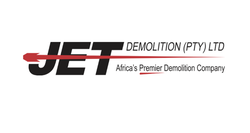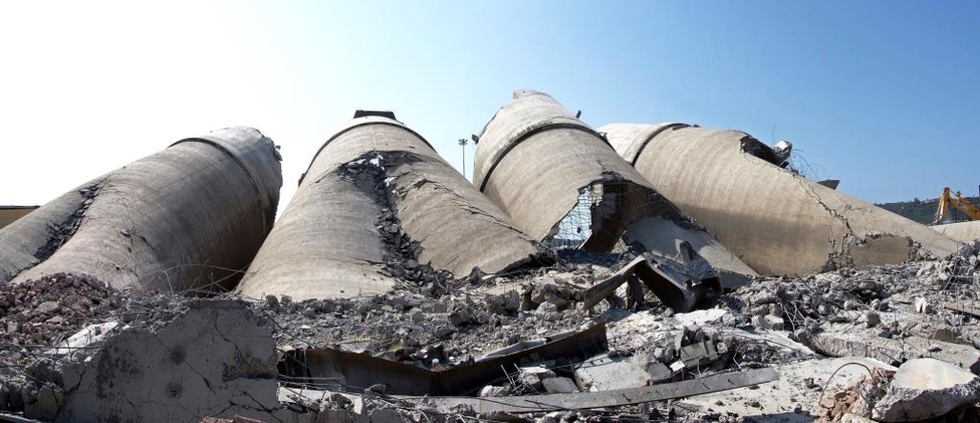Specialised demolition services for furnace structures
| Specialised demolition services for furnace structures_approved | 44 KB | Download | |
| Demolition of redundant electrode from within furnace. | 1.64 MB | Download | |
| Demolition of the redundant refractory lining within the furnace. | 1.82 MB | Download | |
| Gas cutting in preparation for the hot-tap. | 2.79 MB | Download | |
| Lancing of solidified iron. | 1.4 MB | Download | |
| Mechanical removal of molten metals from within the furnace. | 1.49 MB | Download | |
| Removal of refractory lining from within hot-blast main. | 4.97 MB | Download |
The company owns a variety of specialised machines and equipment modified specifically to work within the confined space of a furnace structure. “These specialised machines offer us the best chance of improving on project schedules, resulting in decreased downtime for our clients,” Jet Demolition Contracts Manager Kate Bester (N. Dip. Civil Engineering) comments.
While this particular service itself can be classified as niche or specialised, what makes Jet Demolition’s approach unique is the fact that its teams can transition seamlessly from stave-jacking to lancing and to mechanised removal of massive blocks of solidified iron.
“More often than not, furnace shutdowns are planned over cold winter months, and will be on a 24-hour schedule so as to best minimise production downtime. It is thus the strength, commitment, and discipline of the team that results in a highly successful project completed within time and without incident,” Bester explains.
The elements that require demolition depend greatly on the extent of the maintenance or repair work to be undertaken. Smaller, less serious shutdowns often require only the burden and solidified product from within the furnace to be removed, so as to allow for localised repairs to the refractory and/or insulation lining. Other extensive repairs may call for the demolition and removal of the refractory lining, sections of the shell-plate, or even entire furnace structures so as to facilitate modernised installations.
More often than not, a selection of different methods will come into play, ranging from the hydraulic jacking and removal of staves to the lancing of solidified iron a few meters thick. It is also very common to share a working space with other service providers, where various contractors are working alongside and over and above one another. Thus it is critical to implement a detailed and consistent plan of action, ensuring the safety of all persons during large, intricate, and complicated projects.
Jet Demolition has modified various items of plant and equipment, significantly reducing their overall size, enabling them to fit and manoeuvre in incredibly confined spaces. It has also recently lifted modified mini excavators onto engineered scaffolding, enabling it to demolish refractory lining at height. “This activity has historically only ever been done by hand at this specific facility,” Bester reveals.
“We use specialised lances and tubes, affording us a better burn-rate through solidified iron, and have applied metallurgical research into developing unique wire-packs suited specifically to the base-metals within the furnace to be demolished,” Bester highlights.
Fatigue management and contractor integration are the major challenges associated with work of this nature. Furnace shutdowns typically require extended working hours under extreme conditions, and nearly always involve night-shift activities. It is thus critical to ensure that the teams are well-rested, disciplined, experienced, and well looked after throughout the project.
Due to the nature of the works, it is not uncommon to have a demolition contractor working alongside an installation contractor. As a result, it is imperative that all programmes are wholly integrated, with every person understanding where risk-activities are being executed.
In addition, it is inevitable that furnace demolition activities have an array of extreme conditions and circumstances associated thereto. These range from working in a wet environment during quenching and cooling to working in an extremely hot environment with restricted visibility during lancing activities.
“Just about every element of a furnace structure is large and heavy, and has the potential to cause harm. Thus it is imperative that there is no slip in focus or attention throughout all phases of the works,” Bester concludes.
Ends
Connect with Jet Demolition on Social Media to receive the company’s latest news
Facebook: https://www.facebook.com/JetDemolition/?ref=br_rs
LinkedIn: https://www.linkedin.com/company/jet-demolition-pty-ltd/
Notes to the Editor
To download hi-res images for this release, please visit http://media.ngage.co.za and click the Jet Demolition link to view the company’s press office.
About Jet Demolition
Jet Demolition has been undertaking industrial demolition works since 1994, and is the leading, largest, and most technically-advanced demolition company in Africa. It offers in-house, full-range demolition services, including advanced mechanical solutions and controlled implosions. It actively pursues ongoing development of skills and equipment suited to the changing needs of the industry.
Jet Demolition is a technically-based company, with various staff members holding MSc, BSc, and BTech Degrees, as well as National Diplomas, in various engineering fields. This expertise gives it the technical foundation to successfully engineer solutions for large and complex demolition projects, and furthermore fuels its drive to deliver quality projects safely. Jet Demolition strives to offer its clients innovative and technical solutions to demanding demolition challenges.
Jet Demolition Contact
Kate Bester (NDip Civil Engineering)
Contracts Manager
Phone: (011) 495 3800
Cell: 072 811 5310
Email: kate [at] jetdemolition [dot] co [dot] za
Media Contact
Renay Tandy
NGAGE Public Relations
Phone: (011) 867 7763
Fax: 086 512 3352
Cell: 082 562 5088
Email: renay [at] ngage [dot] co [dot] za
Web: www.ngage.co.za
Browse the NGAGE Media Zone for more client press releases and photographs at http://media.ngage.co.za

